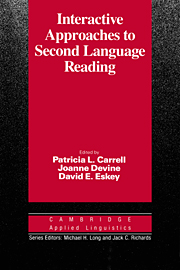Book contents
- Frontmatter
- Contents
- List of contributors
- Series editors' preface
- Preface
- Introduction: Interactive approaches to second language reading
- I INTERACTIVE MODELS OF READING
- II INTERACTIVE APPROACHES TO SECOND LANGUAGE READING – THEORY
- Chapter 5 Schema theory and ESL reading pedagogy
- Chapter 6 Holding in the bottom: an interactive approach to the language problems of second language readers
- Chapter 7 Some causes of text-boundedness and schema interference in ESL reading
- Chapter 8 The short circuit hypothesis of ESL reading – or when language competence interferes with reading performance
- III INTERACTIVE APPROACHES TO SECOND LANGUAGE READING – EMPIRICAL STUDIES
- IV IMPLICATIONS AND APPLICATIONS OF INTERACTIVE APPROACHES TO SECOND LANGUAGE READING – PEDAGOGY
- Index
Chapter 7 - Some causes of text-boundedness and schema interference in ESL reading
Published online by Cambridge University Press: 05 October 2012
- Frontmatter
- Contents
- List of contributors
- Series editors' preface
- Preface
- Introduction: Interactive approaches to second language reading
- I INTERACTIVE MODELS OF READING
- II INTERACTIVE APPROACHES TO SECOND LANGUAGE READING – THEORY
- Chapter 5 Schema theory and ESL reading pedagogy
- Chapter 6 Holding in the bottom: an interactive approach to the language problems of second language readers
- Chapter 7 Some causes of text-boundedness and schema interference in ESL reading
- Chapter 8 The short circuit hypothesis of ESL reading – or when language competence interferes with reading performance
- III INTERACTIVE APPROACHES TO SECOND LANGUAGE READING – EMPIRICAL STUDIES
- IV IMPLICATIONS AND APPLICATIONS OF INTERACTIVE APPROACHES TO SECOND LANGUAGE READING – PEDAGOGY
- Index
Summary
Recent developments in the theory of knowledge representation, going under the general rubric of schema theory (Bartlett 1932; Anderson 1977; Adams and Collins 1979; Rumelhart and Ortony 1977; Rumelhart 1980), have had a pervasive influence on current thinking about text comprehension. Through an emphasis on the role of preexisting knowledge structures in providing information left implicit in text, schema-theoretic approaches have made possible the fairly detailed modeling of many of the active, constructive processes necessary to comprehension (e.g., Schank and Abelson 1977). Within the schematheoretic framework, text comprehension, or more specifically for our purposes, reading comprehension, is characterized as involving an interaction of text-based processes and knowledge-based processes, the latter related to the reader's existing background or schemata (Adams and Collins 1979; Anderson 1977; Rumelhart 1977, 1980; Rumelhart and Ortony 1977; Carrell and Eisterhold 1983, reprinted as Chapter 5 in this volume; and Anderson and Pearson 1984, reprinted as Chapter 3 in this volume).
Schema-theory research has shown that the most efficient processing of text is interactive – a combination of top-down and bottom-up processing modes (Rumelhart 1977, 1980). Top-down processing is the making of predictions about the text based on prior experience or background knowledge, and then checking the text for confirmation or refutation of those predictions. Bottom-up processing is decoding individual linguistic units (e.g., phonemes, graphemes, words) and building textual meaning from the smallest units to the largest, and then modifying preexisting background knowledge and current predictions on the basis of information encountered in the text.
- Type
- Chapter
- Information
- Interactive Approaches to Second Language Reading , pp. 101 - 113Publisher: Cambridge University PressPrint publication year: 1988
- 37
- Cited by

